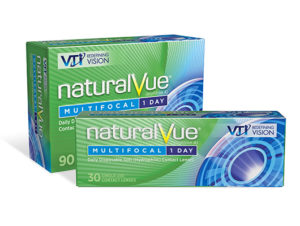

With the escalating use of digital devices by all age groups who are using screens for working or learning at home, more patients are experiencing accommodative eye fatigue. “In one way, that’s good for eye doctors because it’s driving more patients to us. People who were delaying their annual exams have decided that their discomfort is high enough that they are coming back in,” she says.


SLOWING MYOPIA PROGRESSION
Myopia prevalence increased three times in young children during 2020 COVID-19.2 Parents are more aware of their children’s vision demands and time on their devices, providing Dr. Rhue with an opportunity to talk to them about lifestyle shifts and refractive solutions that might help them. She discusses the 20-20-20 rule and emphasizes the importance of outdoor play. She also educates them that each diopter of myopia progression carries higher risk.3
A study by Jeff Cooper and colleagues, using NaturalVue Multifocal 1 Day contact lenses, found that 98 percent of children showed a decrease in myopia progression and 81 percent showed a complete halt of progression, with some showing reversal.4
The study authors subsequently endeavored to report on the NaturalVue Multifocal efficacy over an expanded wear time/follow up of about six years (72 months) and with a larger cohort of 196 patients who had not previously used other interventions, such as soft multifocal contact lenses, orthokeratology, or atropine, for myopic progression.
They found5
- 95 percent of wearers showed a decrease in myopia progression,
- The average myopia progression slowed by approximately 0.85D or 85 percent compared to baseline, statistically significant at all points in time (P<0.05),
- The average myopia progression while wearing the lens never exceeded more than about 0.25D from baseline, and
- Axial length change was measured for a subset of the population5. The average change was approximately 0.10 mm per year through 47 months of follow up.
DIGITAL DEVICE DEMAND CONTINUES
One thing is almost certain: digital devices are here to stay, she says. “We have to figure out how to adjust to what we already do as a society. Limiting digital device time is not always practical, so how can we achieve good outcomes that provide comfortable, clear vision and could help slow the progression of myopia?”
Daily disposable contact lenses are a good option because of the health and convenience benefits.6 More people became aware of hand hygiene during the pandemic, too, so the conversation about replacing contact lenses each day rather than the extra handling involved with cleaning has also become easier,” she says. In addition, many patients prefer wearing contact lenses rather than eyeglasses with their masks. Indeed, many patients who were reluctant to try contact lenses prior to the pandemic are now quite eager to wear them on at least an occasional basis, she says.
EASY TO FIT
With its expanded parameters from +4.00D to -12.25D in 0.25D steps and a single base curve, this lens is also easy to fit, says Dr. Rhue. The Neurofocus Optics® design creates an extended depth of focus to deliver a wider range of clear vision.7 “Patients and the doctor can sense quickly how the lens is going to work for them.” The results have been impressive. VTI has found that NaturalVue Multifocal lens wearers can perform 92 percent of their daily activities without reading glasses, even in low light.8
Dr. Rhue notes that she appreciates the R&D and support that VTI has provided. “The company is so optometry-friendly and is all about innovation and moving forward. It’s been refreshing to work with a company that provides a lens that offers great comfort and design.”
MyPath Myopia Coming Soon


Disclaimer: Dr. Rhue was compensated for her time in preparing this article.
MKT-NVM-AP 60
References:
- VTI Vision
- Wang J, Li Y, Much DC, et al. Prevalence of Myopia in School-Aged Children After COVID-19 Home Confinement. JAMA Ophthalmol. 2021;139(3):293-300.
- Bullimore MA, Brennan NA. Myopia Control: Why Each Diopter Matters. Optom Vis Sci. 2019 Jun;96(6):463-465.
- Cooper J, O’Connor B, Watanabe R, et al. Case series analysis of myopic progression control with a unique extended depth of focus multifocal contact lens. Eye Contact Lens. 2018 Sep;44(5):e16-e24
- Benoit DP, Dillehay SM. (2021, November 4). New Clinical Evidence Through 6 years: NaturalVue Multifocal for Myopia Management, AAO Annual Meeting, Boston, MA.
- Chalmers, R. L., Keay, L., McNally, J., & Kern, J. (2012). Multicenter Case-Control Study of the Role of Lens Materials and Care Products on the Development of Corneal Infiltrates. Optometry and Vision Science. 89(3): 316-325.
- VTI Patents: US6474814_Patent 2002; US7178918_Patent 2007
- VTI data on file 2015. n=59. Data assessed after 1 week of wear.



